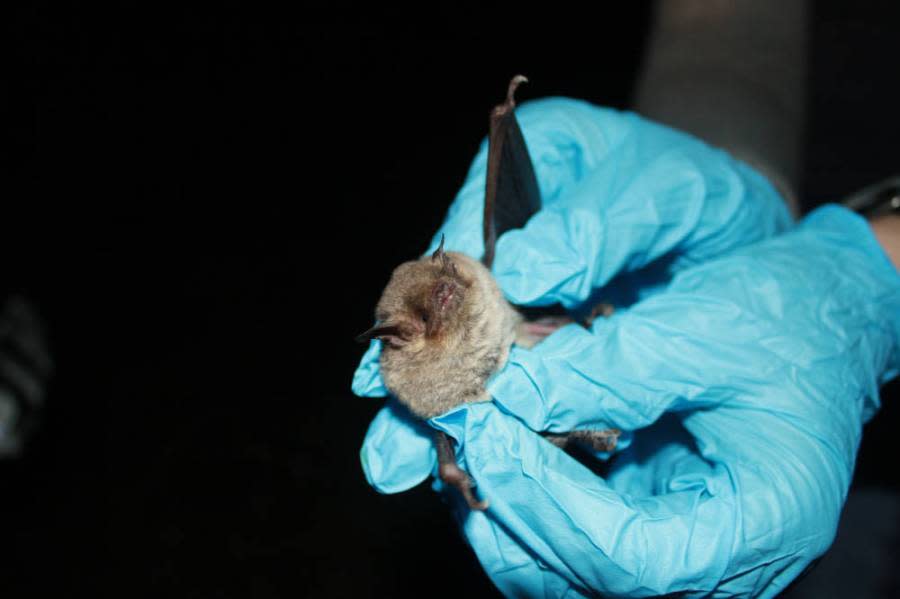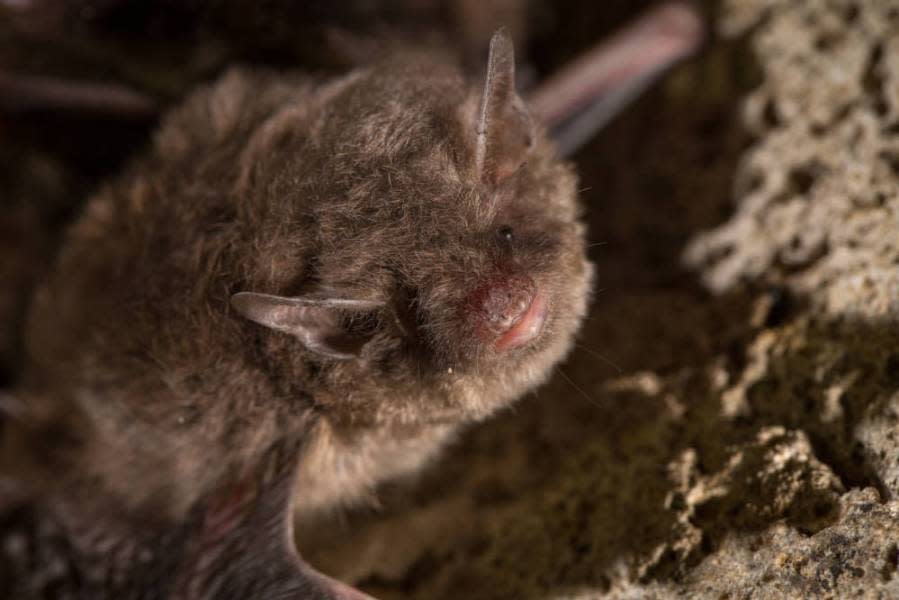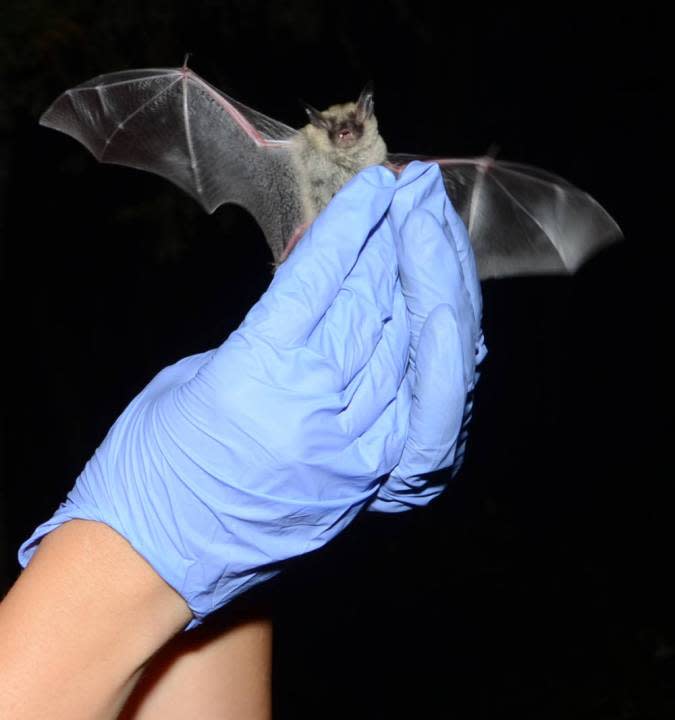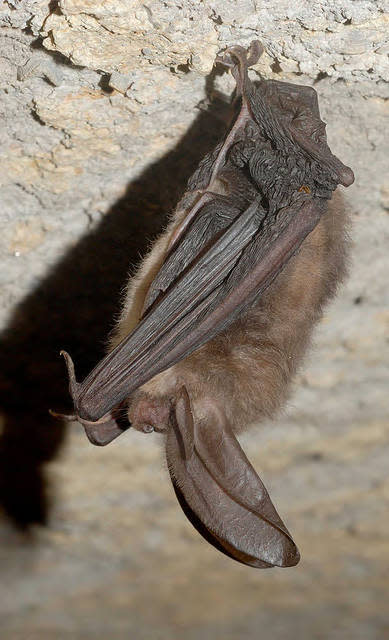Bat Week: These 4 species of bat found in TN are listed as endangered
NASHVILLE, Tenn. (WKRN) — This week, a creature that is often feared is instead being celebrated internationally as various agencies and organizations work to show the important role of bats in nature.
Bat Week, which is recognized from Oct. 24 to Oct. 31, is an annual observation designed to raise awareness about the need for bat conservation, according to the Tennessee Wildlife Resources Agency (TWRA).
White-Nose Syndrome: Fungal disease ‘almost certain death’ for some Tennessee bat colonies
Although it may not always be easy to spot them, bats are hard at work all around the world each night eating tons of insects like moths, mosquitoes and files, pollinating flowers and spreading seeds that grow new plants and trees.
Worldwide, there are more than 1,400 species of bats, making up almost 20% of all mammal species. Tennessee is home to 16 different species of bats, including species like the tricolored bat and big brown bat, with all being insectivores.
However, various threats have made some species vulnerable, with four types of bats found in Tennessee considered endangered. Amid habitat loss and other factors, a fungal disease that has been spreading across the U.S. since 2007 has had devastating impacts on those species.
6 endangered species in Tennessee that are now considered extinct
In a previous interview, U.S. Fish and Wildlife Service (FWS) Biologist Pete Pattavina said white-nose syndrome is causing dramatic declines in multiple species found in Tennessee, and the disease spells “almost certain” death for species such as northern long-eared bats.
Below is more information on the four endangered bats found in Tennessee and the threats they face.
Gray bat

The gray bat is the largest of the “mouse-eared bats” or Myotis species found in Tennessee, according to the TWRA. As can be assumed from its name, its grayish overall color helps distinguish the gray bat from other Myotis bats.
While it can sometimes look russet in the summer, the gray bat is the only Myotis species that shows a nearly uniform grayish-brown color all the way to the base of the hair, and has the wing attached at the ankle joint.
Nearly 86,000 bats found in East Tennessee cave
Other Myotis bats like the little brown bat and northern long-eared bat can be difficult to distinguish from each other without close examination. Gray bats generally hibernate in deep, vertical caves with large chambers, which act as cold air traps and help reduce predators.
They are mainly found in Eastern and Middle Tennessee, including in most counties bordering Davidson County. While they feed on a variety of insects such as mosquitoes, moths and flies, the TWRA said gray bats are partial to mayflies and stone flies.
The gray bat was added to the U.S. List of Endangered and Threatened Wildlife and Plants on April 28, 1976, according to the FWS. At the time, the main threats were human disturbance to roosting bats, environmental contamination and roost modification or destruction.
FWS biologists believe much of that was caused by cave commercialization, with gray bats being particularly sensitive to human disturbance through cave entry and exploration, as well as mine sealing and other modifications to cave entrances.
Five animals in TN you might not have known are endangered
Today, the majority of the Tennessee gray bat population uses only eight caves for hibernation, which, according to the TWRA, makes them very vulnerable to habitat destruction. They also face a more recent threat from white-nose syndrome.
However, conservation efforts have benefited the species. The FWS reports that around 70% of biologically significant summering roost sites across the gray bat’s range are now considered permanently protected.
Indiana bat

The Indiana bat is primarily found in Eastern and Middle Tennessee. They are typically small in size and have a dull, grayish brown to black fur, which is fine and fluffy. When the fur is parted, it appears as a three-color pattern of brownish-black, gray and a cinnamon brown tip.
In Latin, the species is known as Myotis sodalis, which means “companion.” According to the TWRA, the name refers to the Indiana bat’s tendency to hibernate in large, dense clusters of up to 500 bats.
Endangered animals in Tennessee: The species being monitored by U.S. Fish and Wildlife
They winter in the largest and coolest limestone caves and prefer areas in the cave with high humidity. While they can be found in urban parts of Tennessee like Shelby County, Indiana bats rarely inhabit buildings or other man-made structures.
The species is called the Indiana bat because the first bat found in 1928 was discovered in Southern Indiana’s Wyandotte Cave. They eat insects like beetles and caddis flies but have a particular appetite for moths.
The Indiana bat was first listed as in danger of extinction under the Endangered Species Preservation Act of 1966 and is currently listed as endangered under the Endangered Species Act of 1973, according to the FWS.
Did you know? Tennessee is home to one of few endangered spiders
Today, the TWRA estimates there are less than 400,000 individuals, with the majority hibernating in only seven caves in Tennessee. The current population has declined by more than half since the species was first listed as endangered.
Threats to the species include human disturbance of hibernating bats, pesticides, loss of summer habitat, and most recently, white-nose syndrome. According to the FWS, the range-wide population has decreased by 19% since 2007, when white-nose syndrome was first detected in North America.
Northern long-eared bat

The northern long-eared bat is a wide-ranging bat species that can be found in 37 states, including across all of Tennessee. Although, its typically less common than other species found in the state.
As its name suggests, the northern long-eared bat is distinguished from the other similar Myotis species by its longer ears. Their wings are also shaped differently from other bats, making them slow flyers, but very good at navigating through forests and hovering to catch insects.
838 acres added to Fall Creek Falls State Park with caves home to bats, miles of streams
According to the TWRA, some northern long-eared bats have been known to live up to 18 years.
These bats mostly spend the winter hibernating in caves and abandoned mines. During summer, the FWS said they roost alone in small colonies underneath bark or in cavities of both live and dead trees. They emerge at dusk to feed on insects such as spiders, beetles, moths and flies.
Although there are many threats to the species such as habitat loss and wind energy-related mortality, the FWS said white-nose syndrome was the main reason for listing the species as threatened under the Endangered Species Act in 2015.
Amphibians are the world’s most vulnerable animals and threats are increasing
The northern long-eared bat was reclassified as endangered in 2022 as populations continued to decline. According to the FWS, data indicates that white-nose syndrome alone has caused estimated declines of 97 to 100% in affected populations.
If the disease had not emerged, biologists think it is unlikely the northern long-eared bat would be experiencing such a dramatic population decline.
Virginia big-eared bat

As of the FWS’s last review in 2019, the Virginia big-eared bat is only found in a small portion of Eastern Tennessee, just outside of Johnson City. The species has long, soft fur with an overall brownish color and distinctive long ears.
The species is considered a “short-distance migrant”, with a home range of around a 20-mile radius, according to the Virginia Department of Wildlife Resources. However, they have sometimes been recorded moving up to 40 miles between summer and winter roosts.
They typically feed over corn fields, pastures, hay fields, small woodlots and large forested tracts, eating everything from beetles and flies to wasps and grasshoppers. However, their favorite food appears to be moths.
⏩ Read today’s top stories on wkrn.com
When the Virginia big-eared bat was listed as an endangered species in 1979, biologists believed their population was only around 3,500 bats. However, the population has grown over the years, with the last count in 2018 estimating a population of around 19,500 bats, according to the FWS.
It’s the species’ concentration in a limited number of sites that continues to make it vulnerable to threats like loss and degradation of roosts, as well as foraging areas. The Virginia big-eared bat population has also been affected by white-nose syndrome.
For the latest news, weather, sports, and streaming video, head to WKRN News 2.

